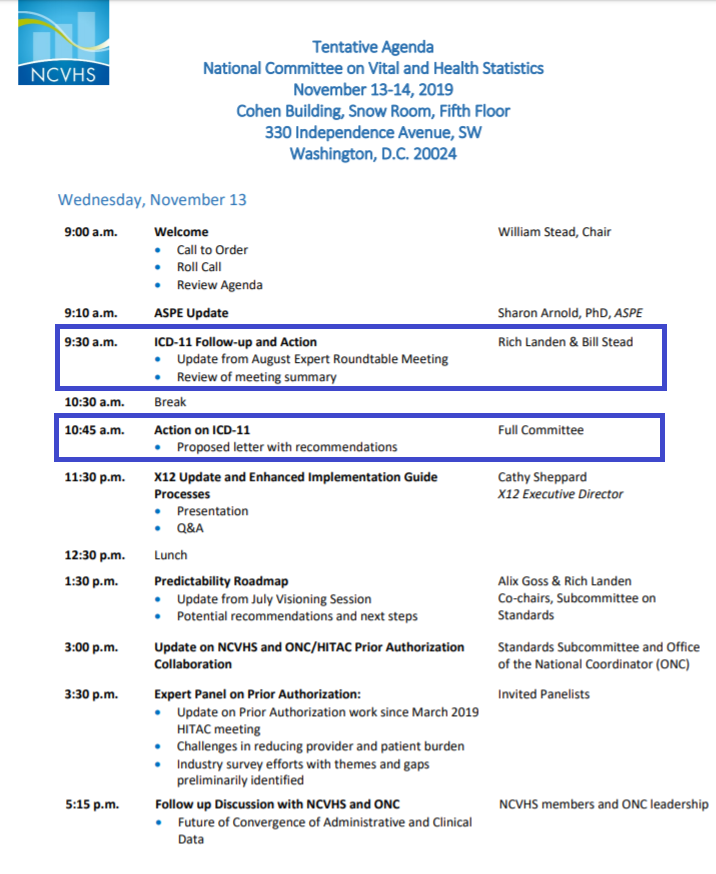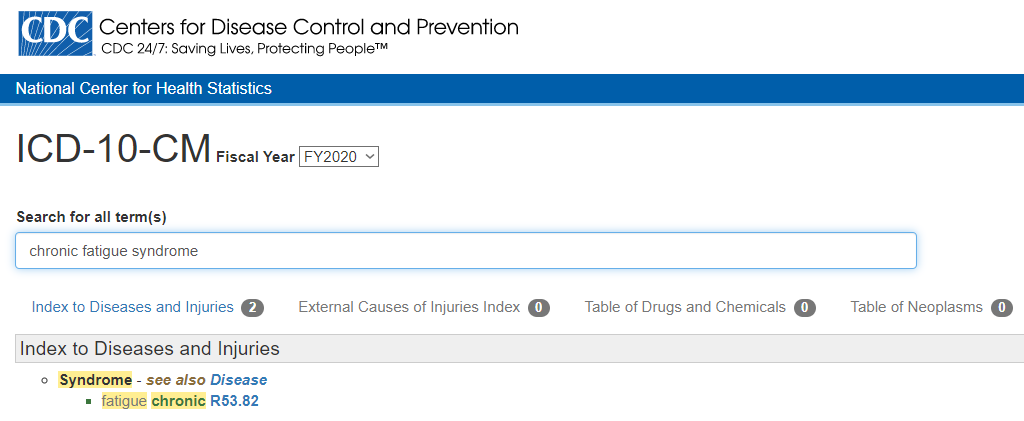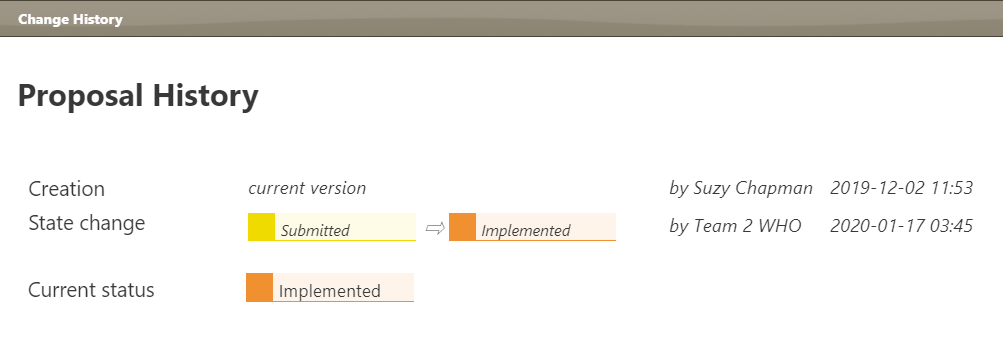Dx Revision Watch
Senior Member (Voting Rights)
ICD-11 Proposal Mechanism and the "Proposal History" feature:
The "Proposal History" feature has recently been restored to the ICD-11 Proposal Mechanism platform. This feature was removed from the platform several years ago.
In order to view and interact with the Proposal Mechanism stakeholders are first required to register an account.
Register here: https://icd.who.int/dev11/Account/Register
In order to track the history of a proposal through the review process: log in and locate the proposal in the Proposal List using the Search function https://icd.who.int/dev11/proposals/f/en/ProposalList
You can search for proposals by searching for the submitter's username or by entering a disorder term, then clicking the "Filter" button.
Open the proposal whose history you wish to track and click on the orange "proposal history" button (located upper right of the screen):

A window will open displaying the proposer's name, the original submission date, the proposal's progress through the review system and its current status.
Some proposals will have been reviewed by one of the several Proposal Mechanism Admin Teams; some will be referred on to WHO classification experts for their consideration and/or to the ICD-11 Medical Scientific Advisory Committee (MSAC) or Classifications and Statistics Advisory Commitee (CSAC) committees for their consideration.

Following processing, some decisions to Approve and Implement or Reject a proposal are accompanied by a brief rationale. If a Rationale has been provided, these can be found on the proposal window under the heading "Comments on this proposal". (Rationales for decisions, where provided, are not included with the "Proposal History" details.)
In the example above, I have used the Proposal History for the WHO's Rejection on November 19, 2018 of the November 6, 2017 proposal submitted by Dr Tarun Dua to relocate the terms "Myalgic encephalitis/Chronic Fatigue Syndrome (ME/CFS)" [sic] to the Symptoms, signs chapter as a child under Symptoms, signs or clinical findings of the musculoskeletal system. This decision to reject the proposal submitted by Dr Dua was supported by the MSAC and CSAC committees:
Dr Tarun Dua proposal*:
https://icd.who.int/dev11/proposals...lGroupId=303c7493-554a-44c8-8e00-bd0c6c4cc6ef
*According to Dr Dua, this proposal had apparently been submitted on behalf of the external Topic Advisory Group (TAG) for Neurology which had ceased to operate beyond October 2016. Dr Dua had served as WHO Lead Secretariat and Managing Editor to TAG Neurology during its period of operation. The proposal, according to a clarification issued by Dr Dua, "represented the TAG's earlier conclusions." It remains unclear why the TAG had not presented this proposal during its period of operation.
Further reading:
Update on the classification of PVFS, ME and CFS for ICD-11 ICD-11 Report One | November 2019, prepared by Suzy Chapman, Dx Revision Watch for The ME Global Chronicle
https://dxrevisionwatch.files.wordp...n-classification-of-pvfs-me-cfs-for-icd11.pdf
ICD-11 Proposal Mechanism, status of processed proposals at 01.11.19 v4, prepared by Suzy Chapman, Dx Revision Watch
https://dxrevisionwatch.files.wordpress.com/2019/10/outcome-of-icd-11-processed-proposals-v4.pdf
The "Proposal History" feature has recently been restored to the ICD-11 Proposal Mechanism platform. This feature was removed from the platform several years ago.
In order to view and interact with the Proposal Mechanism stakeholders are first required to register an account.
Register here: https://icd.who.int/dev11/Account/Register
In order to track the history of a proposal through the review process: log in and locate the proposal in the Proposal List using the Search function https://icd.who.int/dev11/proposals/f/en/ProposalList
You can search for proposals by searching for the submitter's username or by entering a disorder term, then clicking the "Filter" button.
Open the proposal whose history you wish to track and click on the orange "proposal history" button (located upper right of the screen):

A window will open displaying the proposer's name, the original submission date, the proposal's progress through the review system and its current status.
Some proposals will have been reviewed by one of the several Proposal Mechanism Admin Teams; some will be referred on to WHO classification experts for their consideration and/or to the ICD-11 Medical Scientific Advisory Committee (MSAC) or Classifications and Statistics Advisory Commitee (CSAC) committees for their consideration.

Following processing, some decisions to Approve and Implement or Reject a proposal are accompanied by a brief rationale. If a Rationale has been provided, these can be found on the proposal window under the heading "Comments on this proposal". (Rationales for decisions, where provided, are not included with the "Proposal History" details.)
In the example above, I have used the Proposal History for the WHO's Rejection on November 19, 2018 of the November 6, 2017 proposal submitted by Dr Tarun Dua to relocate the terms "Myalgic encephalitis/Chronic Fatigue Syndrome (ME/CFS)" [sic] to the Symptoms, signs chapter as a child under Symptoms, signs or clinical findings of the musculoskeletal system. This decision to reject the proposal submitted by Dr Dua was supported by the MSAC and CSAC committees:
Dr Tarun Dua proposal*:
https://icd.who.int/dev11/proposals...lGroupId=303c7493-554a-44c8-8e00-bd0c6c4cc6ef
*According to Dr Dua, this proposal had apparently been submitted on behalf of the external Topic Advisory Group (TAG) for Neurology which had ceased to operate beyond October 2016. Dr Dua had served as WHO Lead Secretariat and Managing Editor to TAG Neurology during its period of operation. The proposal, according to a clarification issued by Dr Dua, "represented the TAG's earlier conclusions." It remains unclear why the TAG had not presented this proposal during its period of operation.
Further reading:
Update on the classification of PVFS, ME and CFS for ICD-11 ICD-11 Report One | November 2019, prepared by Suzy Chapman, Dx Revision Watch for The ME Global Chronicle
https://dxrevisionwatch.files.wordp...n-classification-of-pvfs-me-cfs-for-icd11.pdf
ICD-11 Proposal Mechanism, status of processed proposals at 01.11.19 v4, prepared by Suzy Chapman, Dx Revision Watch
https://dxrevisionwatch.files.wordpress.com/2019/10/outcome-of-icd-11-processed-proposals-v4.pdf
Last edited:







